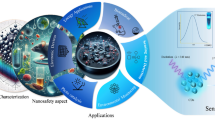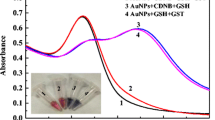Abstract
Naked-eye semi-quantitative (NEQ) assays should exhibit vivid color variations and one-to-one correspondence between the analyte concentrations and the color display. Herein, we report a bisubstrate multi-colorimetric system, constituted by 3,3′,5,5′-tetramethylbenzidine (TMB) and dopamine (DA), which carries out a controllable NEQ assay based on the complementary colorharmonic principle. This bisubstrate system is a universal threshold NEQ assay with tunable sensitivity and detection window depending on the H2O2 concentration. The peroxidase-like activity of PEG@Fe3O4 NPs was used to catalyze the oxidations of TMB and DA by H2O2 to the colored products. On the basis of UV–vis spectra data, it was speculated that the oxidation product of TMB (TMB·+) could oxidize DA in this system. The concentration of DA controls the consumption of oxidant (H2O2) and the oxidation of TMB. By controlling the molar ratio of TMB to DA, the bisubstrate system precisely showed multicolor displays (e.g., three-color display: orange, gray, and blue) at submillimolar and millimolar concentrations of H2O2. The detection limit and sensitivity for H2O2 were 0.4 mM and 0.1 mM, respectively. Next, the system was applied to the threshold detection of hypoglycemia (orange), normal (gray), and hyperglycemia (blue) in spiked samples on both gel- and paper-based test strips. Digitalized colorimetric results using the red–green–blue (RGB) analysis with smartphone application were achieved. This work provides a new strategy of multi-colorimetric assay that takes advantages of controllability, threshold detection, vivid color variations, and reproducibility (CVs were 1.1–2.1%), which could be potentially useful for in-field and point-of-care applications.
Graphical abstract








Similar content being viewed by others
Data availability
All data generated or analyzed during this study are included in this published article and its supplementary information files.
Code availability
Not applicable.
References
Ma XM, He S, Qiu B, Luo F, Guo LH, Lin ZY (2019) Noble metal nanoparticle-based multicolor immunoassays: an approach toward visual quantification of the analytes with the naked eye. ACS Sensors 4:782–791. https://doi.org/10.1021/acssensors.9b00438
Tang LH, Li JH (2017) Plasmon-based colorimetric nanosensors for ultrasensitive molecular diagnostics. ACS Sensors 2:857–875. https://doi.org/10.1021/acssensors.7b00282
Elghanian R, Storhoff JJ, Mucic RC, Letsinger RL, Mirkin CA (1997) Selective colorimetric detection of polynucleotides based on the distance-dependent optical properties of gold nanoparticles. Science 277:1078–1081. https://doi.org/10.1126/science.277.5329.1078
Ma XM, Chen ZT, Kannan P, Lin ZY, Qiu B, Guo LH (2016) Gold nanorods as colorful chromogenic substrates for semiquantitative detection of nucleic acids, proteins, and small molecules with the naked eye. Anal Chem 88:3227–3234. https://doi.org/10.1021/acs.analchem.5b04621
Chen ZT, Lin Y, Ma XM, Guo LH, Qiu B, Chen GN, Lin ZY (2017) Multicolor biosensor for fish freshness assessment with the naked eye. Sens Actuator B-Chem 252:201–208. https://doi.org/10.1016/j.snb.2017.06.007
Guo YH, Wu J, Li J, Ju HX (2016) A plasmonic colorimetric strategy for biosensing through enzyme guided growth of silver nanoparticles on gold nanostars. Biosens Bioelectron 78:267–273. https://doi.org/10.1016/j.bios.2015.11.056
Xu SH, Ouyang WJ, Xie PS, Lin Y, Qin B, Lin ZY, Chen GN, Guo LH (2017) Highly uniform gold nanobipyramids for ultrasensitive colorimetric detection of influenza virus. Anal Chem 89:1617–1623. https://doi.org/10.1021/acs.analchem.6b03711
Chen P, Liu XH, Goyal G, Tran NT, Ho JCS, Wang Y, Aili D, Liedberg B (2018) Nanoplasmonic sensing from the human vision perspective. Anal Chem 90:4916–4924. https://doi.org/10.1021/acs.analchem.8b00597
Cooper SS (1941) The mixed indicator bromocresol green-methyl red for carbonates in water. Ind Eng Chem Anal Ed 13:0466–0470. https://doi.org/10.1021/i560095a011
MacAdam DL (1938) Photometric relationships between complementary colors. J Opt Soc Am 28:103–111. https://doi.org/10.1364/josa.28.000103
Wang QQ, Wei H, Zhang ZQ, Wang EK, Dong SJ (2018) Nanozyme: An emerging alternative to natural enzyme for biosensing and immunoassay. Trac-Trends Anal Chem 105:218–224. https://doi.org/10.1016/j.trac.2018.05.012
Wei H, Wang EK (2013) Nanomaterials with enzyme-like characteristics (nanozymes): next-generation artificial enzymes. Chem Soc Rev 42:6060–6093. https://doi.org/10.1039/c3cs35486e
Wu JJX, Wang XY, Wang Q, Lou ZP, Li SR, Zhu YY, Qin L, Wei H (2019) Nanomaterials with enzyme-like characteristics (nanozymes): next-generation artificial enzymes (ii). Chem Soc Rev 48:1004–1076. https://doi.org/10.1039/c8cs00457a
Gao LZ, Zhuang J, Nie L, Zhang JB, Zhang Y, Gu N, Wang TH, Feng J, Yang DL, Perrett S, Yan XY (2007) Intrinsic peroxidase-like activity of ferromagnetic nanoparticles. Nat Nanotechnol 2:577–583. https://doi.org/10.1038/nnano.2007.260
Tracey CT, Torlopov MA, Martakov IS, Vdovichenko EA, Zhukov M, Krivoshapkin PV, Mikhaylov VI, Krivoshapkina EF (2020) Hybrid cellulose nanocrystal/magnetite glucose biosensors. Carbohydr Polym 247:116704. https://doi.org/10.1016/j.carbpol.2020.116704
Duan DM, Fan KL, Zhang DX, Tan SG, Liang MF, Liu Y, Zhang JL, Zhang PH, Liu W, Qiu XG, Kobinger GP, Gao GF, Yan XY (2015) Nanozyme-strip for rapid local diagnosis of Ebola. Biosens Bioelectron 74:134–141. https://doi.org/10.1016/j.bios.2015.05.025
Zakharzhevskii M, Drozdov AS, Kolchanov DS, Shkodenko L, Vinogradov VV (2020) Test-system for bacteria sensing based on peroxidase-like activity of inkjet-printed magnetite nanoparticles. Nanomaterials 10:313. https://doi.org/10.3390/nano10020313
Kip C, Akbay E, Gokcal B, Savas BO, Onur MA, Tuncel A (2020) Colorimetric determination of tumor cells via peroxidase-like activity of a cell internalizable nanozyme: hyaluronic acid attached-silica microspheres containing accessible magnetite nanoparticles. Colloid Surface A 598:124812. https://doi.org/10.1016/j.colsurfa.2020.124812
Zhang ZJ, Zhang XH, Liu BW, Liu JW (2017) Molecular imprinting on inorganic nanozymes for hundred-fold enzyme specificity. J Am Chem Soc 139:5412–5419. https://doi.org/10.1021/jacs.7b00601
Wang H, Li S, Si YM, Zhang N, Sun ZZ, Wu H, Lin YH (2014) Platinum nanocatalysts loaded on graphene oxide-dispersed carbon nanotubes with greatly enhanced peroxidase-like catalysis and electrocatalysis activities. Nanoscale 6:8107–8116. https://doi.org/10.1039/c4nr00983e
Chen WH, Vazquez-Gonzalez M, Kozell A, Cecconello A, Willner I (2018) Cu2+-modified metal-organic framework nanoparticles: a peroxidase-mimicking nanoenzyme. Small 14:8. https://doi.org/10.1002/smll.201703149
Purcell GV, Behenna DB, Walsh PR (1979) Evaluation of the BMC glucose oxidase/peroxidase-4-aminophenazone-phenol procedure for glucose as adapted to the Technicon SMAC. Clin Chem 25:1844–1846
Ye HH, Yang KK, Tao J, Liu YJ, Zhang Q, Habibi S, Nie ZH, Xia XH (2017) An enzyme-free signal amplification technique for ultrasensitive colorimetric assay of disease biomarkers. ACS Nano 11:2052–2059. https://doi.org/10.1021/acsnano.6b08232
Childs RE, Bardsley WG (1975) Steady-state kinetics of peroxidase with 2,2’-azino-di-(3-ethylbenzthiazoline-6-sulphonic acid) as chromogen. Biochem J 145:93–103. https://doi.org/10.1042/bj1450093
Stefan L, Denat F, Monchaud D (2012) Insights into how nucleotide supplements enhance the peroxidase-mimicking DNAzyme activity of the G-quadruplex/hemin system. Nucleic Acids Res 40:8759–8772. https://doi.org/10.1093/nar/gks581
Josephy PD, Eling T, Mason RP (1982) The horseradish peroxidase-catalyzed oxidation of 3,5,3’,5’-tetramethylbenzidine: free radical and charge-transfer complex intermediates. J Biol Chem 257:3669–3675
Loynachan CN, Soleimany AP, Dudani JS, Lin YY, Najer A, Bekdemir A, Chen Q, Bhatia SN, Stevens MM (2019) Renal clearable catalytic gold nanoclusters for in vivo disease monitoring. Nat Nanotechnol 14:883–890. https://doi.org/10.1038/s41565-019-0527-6
Sun SH, Zeng H (2002) Size-controlled synthesis of magnetite nanoparticles. J Am Chem Soc 124:8204–8205. https://doi.org/10.1021/ja026501x
Fu Y, Li XD, Chen HD, Wang ZX, Yang WS, Zhang HM (2019) CXC chemokine receptor 4 antagonist functionalized renal clearable manganese-doped iron oxide nanoparticles for active-tumor-targeting magnetic resonance imaging-guided bio-photothermal therapy. ACS Appl Bio Mater 2:3613–3621. https://doi.org/10.1021/acsabm.9b00475
Jiang B, Duan DM, Gao LZ, Zhou MJ, Fan KL, Tang Y, Xi JQ, Bi YH, Tong Z, Gao GF, Xie N, Tang A, Nie GH, Liang MM, Yan XY (2018) Standardized assays for determining the catalytic activity and kinetics of peroxidase-like nanozymes. Nat Protoc 13:1506–1520. https://doi.org/10.1038/s41596-018-0001-1
Wei H, Wang EK (2008) Fe3O4 magnetic nanoparticles as peroxidase mimetics and their applications in H2O2 and glucose detection. Anal Chem 80:2250–2254. https://doi.org/10.1021/ac702203f
Asati A, Santra S, Kaittanis C, Nath S, Perez JM (2009) Oxidase-like activity of polymer-coated cerium oxide nanoparticles. Angew Chem Int Edit 48:2308–2312. https://doi.org/10.1002/anie.200805279
Bisaglia M, Mammi S, Bubacco L (2007) Kinetic and structural analysis of the early oxidation products of dopamine: analysis of the interactions with alpha-synuclein. J Biol Chem 282:15597–15605. https://doi.org/10.1074/jbc.M610893200
Jang GG, Roper DK (2011) Balancing redox activity allowing spectrophotometric detection of Au(I) using tetramethylbenzidine dihydrochloride. Anal Chem 83:1836–1842. https://doi.org/10.1021/ac102668q
Pham AN, Waite TD (2014) Cu(II)-catalyzed oxidation of dopamine in aqueous solutions: mechanism and kinetics. J Inorg Biochem 137:74–84. https://doi.org/10.1016/j.jinorgbio.2014.03.018
Borsook H, Keighley G (1933) Oxidation-reduction potential of ascorbic acid (Vitamin C). Proc Natl Acad Sci U S A 19:875–878. https://doi.org/10.1073/pnas.19.9.875
Simic MG, Jovanovic SV (1989) Antioxidation mechanisms of uric acid. J Am Chem Soc 111:5778–5782. https://doi.org/10.1021/ja00197a042
Funding
This work was supported by the National Natural Science Foundation of China (Grant No. 61901438) and Science and Technology Developing Foundation of Jilin Province (Grant No. 20200404192YY).
Author information
Authors and Affiliations
Contributions
Min Su: conceptualization, methodology, investigation, data analysis, writing—original draft. Hongda Chen: resources. Hua Zhang: funding acquisition, resources. Zhenxin Wang: conceptualization, writing—review and editing, supervision, resources.
Corresponding authors
Ethics declarations
Ethics approval
Not applicable.
Consent to participate
Not applicable.
Consent for publication
Not applicable.
Conflict of interest
The authors declare no competing interests.
Additional information
Publisher's note
Springer Nature remains neutral with regard to jurisdictional claims in published maps and institutional affiliations.
Supplementary Information
Below is the link to the electronic supplementary material.
604_2022_5169_MOESM1_ESM.docx
Reagents and apparatus, additional detailed experiment procedures, HRTEM image, EDS analysis and magnetic measurement of as-prepared Fe3O4 NPs, pH optimization, steady-state kinetic assay of PEG@Fe3O4 NPs, time evolution UV–vis absorption spectra of bisubstrate systems, time-dependent colorimetric results of the TMB system, repeatability test of the bisubstrate multi-colorimetric assay, analytical results of the test strips by smartphone app. (DOCX 23.2 MB)
Rights and permissions
About this article
Cite this article
Su, M., Chen, H., Zhang, H. et al. Controllable bisubstrate multi-colorimetric assay based on peroxidase-like nanozyme and complementary colorharmonic principle for semi-quantitative detection of H2O2 with the naked eye. Microchim Acta 189, 81 (2022). https://doi.org/10.1007/s00604-022-05169-w
Received:
Accepted:
Published:
DOI: https://doi.org/10.1007/s00604-022-05169-w




